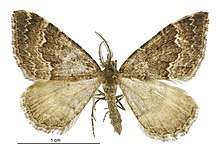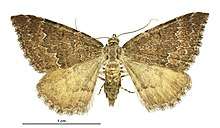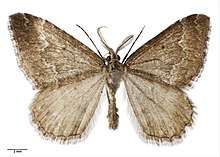Asaphodes ida
Asaphodes ida is a species of moth in the family Geometridae. It is endemic to New Zealand. This moth can be found in upland or alpine habitat in Canterbury and Otago. Although not classified under the New Zealand Threat Classification system this species is regarded as rare.
| Asaphodes ida | |
|---|---|
 | |
| Male | |
 | |
| Female | |
| Scientific classification | |
| Kingdom: | Animalia |
| Phylum: | Arthropoda |
| Class: | Insecta |
| Order: | Lepidoptera |
| Family: | Geometridae |
| Genus: | Asaphodes |
| Species: | A. ida |
| Binomial name | |
| Asaphodes ida (Clarke, 1926)[1] | |
| Synonyms[2] | |
| |
Taxonomy
This species was described by Charles E. Clarke in 1926 as Xanthorhoe ida using material collected by George Howes in February at Eweburn Stream, Mount Ida in Canterbury.[3][2] George Hudson discussed and illustrated this species as Xanthorhoe ida in 1928.[4] In 1987 Robin C. Craw, after considering the genital structure of this species, proposed assigning this species to the genus Asaphodes.[5] In 1988 John S. Dugdale agreed with this proposal.[2] The holotype specimen is held at the Auckland War Memorial Museum.[2]
Description
Clarke described the species as follows:
♂. 24 mm. Head, palpi, and thorax grey-fuscous. Antennae fuscous, pectinations 6. Abdomen grey-fuscous. Forewings elongate-triangular, costa outwardly rounded, apex bluntly pointed, termen slightly sinuate, oblique; brown-ocherous with admixture of reddish, lines white; an irregular wide transverse band at 1⁄4, outwardly convex in middle, slightly reddish with narrow white edges on either side; at 3⁄4 a transverse dentate white line with largest dentations outwardly about middle; reddish beyond this and then darkening into brown-ochreous towards termen; a blackish discal dot; subterminal line dentate, white, inwardly edged with dark brown: cilia dark fuscous. Hindwings dark grey-ochreous on inner half, externally lighter ochreous, crenulate markings along termen: cilia dark fuscous.[3]
Distribution

This species is endemic to New Zealand.[1][6] It is found in the Ida Range in Canterbury as well as the Hawkdun Range in Central Otago.[7] This moth is regarded as being rare.[7]
Biology and life cycle
A. ida is on the wing in February.[3]
Habitat and host plant
A. ida frequents upland or alpine wetland habitat at between 800 and 1,100 meters in altitude.[8][9]
References
| Wikimedia Commons has media related to Asaphodes ida. |
- "Asaphodes ida (Clarke, 1926)". www.nzor.org.nz. Landcare Research New Zealand Ltd. Retrieved 22 August 2018.
- Dugdale, J. S. (1988). "Lepidoptera - annotated catalogue, and keys to family-group taxa" (PDF). Fauna of New Zealand. 14: 173. Retrieved 22 August 2018.
- Clarke, Charles E. (1926). "New species of Lepidoptera". Transactions and Proceedings of the New Zealand Institute. 56: 417–421. Retrieved 25 August 2018.
- Hudson, G. V. (1928). The Butterflies and Moths of New Zealand. Wellington: Ferguson & Osborn Ltd. p. 116. OCLC 25449322.
- Craw, R. C. (2 February 2012). "Revision of the genus Helastia sensu stricto with description of a new genus (Lepidoptera: Geometridae: Larentiinae)". New Zealand Journal of Zoology. 14 (2): 269–293. doi:10.1080/03014223.1987.10422997.
- Gordon, Dennis P., ed. (2010). New Zealand Inventory of Biodiversity, Volume Two, Kingdom Animalia: Chaetognatha, Ecdysozoa, Ichnofossils. Vol. 2. Christchurch, N.Z.: Canterbury University Press. p. 459. ISBN 9781877257933. OCLC 973607714.
- Crown Pastoral Land Tenure Review:Michael Peak. Conservation Resources Report (PDF) (Report). Department of Conservation. p. 14. Retrieved 25 August 2018.
- Patrick, Brian (2014). "Ecology and conservation of the rare moth Asaphodes frivola Meyrick". The Weta. 47: 17–38.
- Brian., Patrick (1989). Lepidoptera, Cicadidae, Acrididae of the Manorburn Ecological District. New Zealand. Department of Conservation. Science and Research Directorate. Wellington, N.Z.: Head Office, Dept. of Conservation. p. 4. ISBN 978-0478011449. OCLC 154271965.